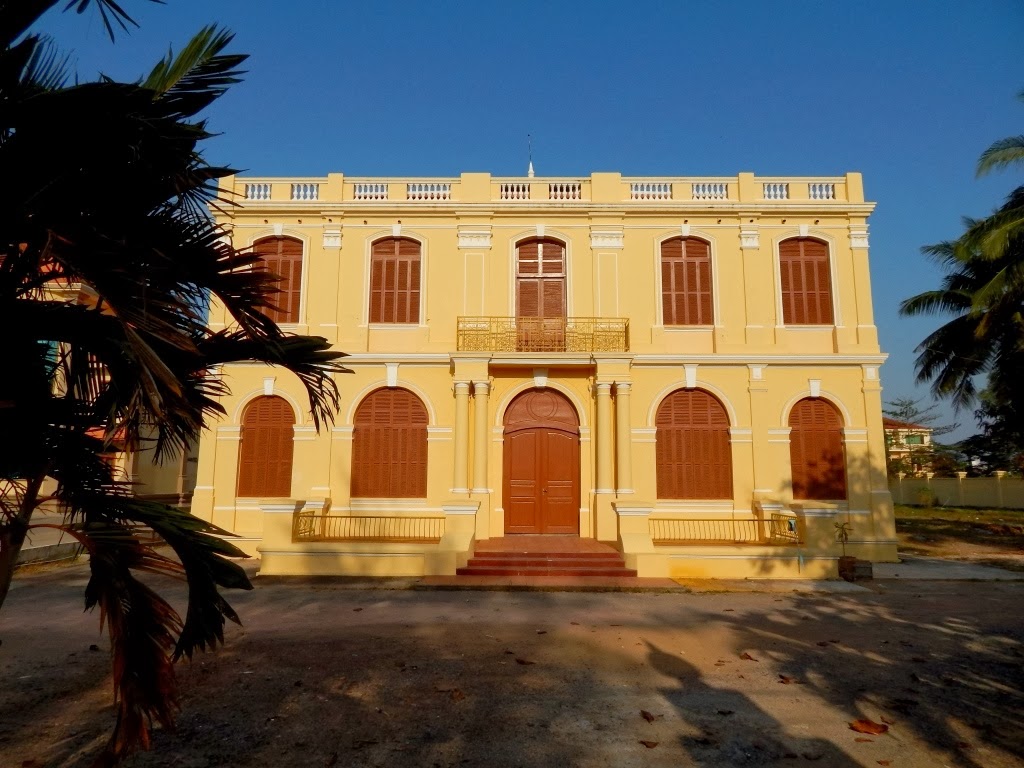20. Modernism in Cambodia, 1950s-60s
"The New Khmer Architecture" 1960s, Phnom Penh
Without a doubt, the city and architecture of Phnom Penh is one of the urban highlights of my trip. I referred in earlier posts to the rich fabric, still existing in whole ensembles and city blocs of the colonial French architecture (Cambodia was a French 'Protectorate', not a colony, but the term 'colonial' is used in this context) The iconic apartment building architecture, and what I am concerned the type of the French-designed corner apartment building in Phnom Penh, are still very much prevalent, some examples even beautifully, and correctly restored.
After the independence of the country, for the first time, local Cambodian architects had more and more the opportunity to design buildings in the city, and the country. Of course their studies took them with the help of scholarships to the major architecture schools in Paris. While studying there, the strong influence of Le Corbusiers' building designs and theories was evident, in France and in the world. The Cambodian students must have absorbed his teachings and examples in awe, like the students elsewhere.
 |
| Teacher Training College (now Institute of Foreign Languages), Vann Molyvann, 1972 |
Cambodia's most prominent architect, Vann Molyvann, now in his mid eighty's and after a long exile in Switzerland again home in his city, went also to Paris with a French scholarship, like many others, initially not to study architecture, but law. After the switch in majors and the completion of his architecture studies he returned to Cambodia to execute a number of the country's key projects.
Unfortunately, some of Molyvann's iconic buildings were demolished already, to make space for more profitable, faceless developer architecture of a mediocre-kind. Lost forever are the Preah Suramarit National Theater, Vann Molyvann, 1968, damaged in a fire and demolished 2008, the Council of Ministers complex, Vann Molyvann and Grimeret, 1950s, demolished 2008, close to demolition are several examples of the so-called "100 Houses" complex, Vann Molyvann.
 |
| Single-family houses of the "100 Hundred Houses" complex, Phnom Penh, for employees of the National Bank of Cambodia, Vann Molyvann |
 |
| "100 Hundred Houses" complex, Vann Molyvann |
One of my riding buddies is friends with Molyvann's son-in-law and I hope to meet the great old man when I return in December. Maybe he sheds more light on the current condition of preservation of the Cambodian classic modern movement, the "New Khmer Architecture". I hope I have a chance to meet him.
 |
| National Sports Complex, Olympic Stadium, Vann Molyvann, Um Samuth, Gérald Hanning, Claude Duchemin, Jean-Claude Morin, 1964 |
An extraordinary loss would be the demolition of Molyvann's design of the Cambodia National Sports Complex/Olympic Stadium. One can called it more than a rumor that the government considers this stadium a negligible, 'useless' entity, which -most likely- will have to make space for more of the same, a mixed-used commercial complex, whose first phase, named by the developers shamelessly "The Miracle of Phnom Penh", is currently completing the structural concrete work.
It is not the lack of knowledge how to restore the architectural heritage of the 1950s and 1960s which is to blame. It is the incredible greed of the decision-makers, who sell out to foreign interests.
 |
| Royal University of Phnom Penh, Main auditorium, Leroy & Mondet, 1968 |
The "New Khmer Architecture" was not Vann Molyvann's work alone, but also the result of contributions by modernist foreign architects, such as the Frenchmen Leroy & Mondet, Royal University of Phnom Penh, 1968, Henri Chatel and Jamshed Petrigura, National Bank Apartments (now part of the Russian Embassy), and architecture teams from the former Soviet Union (Institute of technology, University of Phnom Penh).
What was once a model for modern, low-income municipal housing in Phnom Penh, is today a venerable slum. Once called the "White Building", the 300 meter long, five story complex on the Bassac Riverfront: Municipal Apartments, Lu Ban Hap with Vladimir Bodiansky, 1963, is today a much altered and added on housing complex which -most likely- will be demolished in the near future.
 |
| Municipal Apartments, "The White Building", Lu Ban Hap with Vladimir Bodiansky, 1963 |
 |
| Municipal Apartments, 1963 |
An interesting example of a new interpretation of what "New Khmer Architecture" could mean today is a narrow, maybe 4.00 meter wide building on prominent Preah Sisowath Quay (Riverside), owned by the personal physician of the Prime Minister. The six-story structure was completed two years ago, still awaits the first tenant (monthly rent for the entire building in this prime location: U.S.$5,000). It is probably very interesting to see the interior, which has several multi-story spaces, only 3 bedrooms and a narrow rooftop lap-pool. I couldn't find anything about the architect but will try some more research.





















































